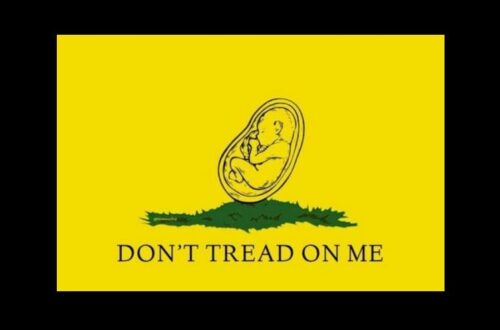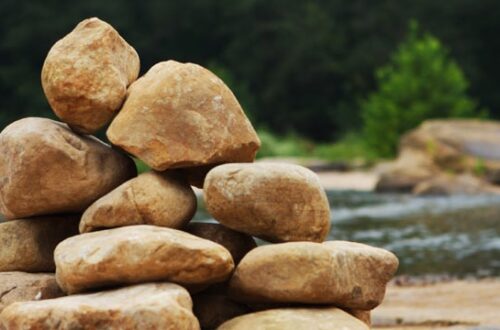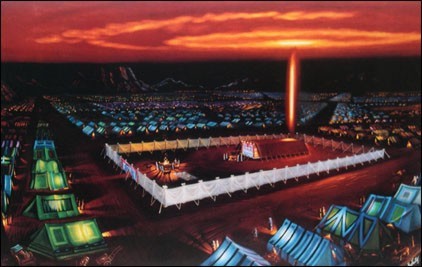
The Tabernacle of Moses – God’s Heavenly Pattern for our Spiritual Transformation – Part I: The Outer Court
The design for the Tabernacle of Moses (or Tent of Meeting) was given to Moses by God while on Mount Sinai, and it is based upon the Tabernacle in Heaven (Hebrews 8:5. Exodus 25:40). This Earthly Tabernacle was to prophetically point the way to God the Father through Jesus; therefore, no error was allowed in its construction. Furthermore, the building of the Tabernacle reveals the ultimate desire of God our Father – to live amongst us His children (Exodus 25:8). Oh, the joy of God when He became flesh and dwelt amongst His people – Emmanuel (i.e., God with us)! (John 1:14)
The Israelites constructed the Tabernacle at the foot of Mount Sinai in 1445 BC, just eleven months after the Exodus from Egypt. It was built from the free-will offerings of the people (Exodus 35:5). The people brought too much for the temple, so God had Moses stop them from bringing any more offerings for this Tabernacle (Exodus 36:3,5,6,7). What an excellent problem to have! It was central to Israel’s worship and sacrificial system for 485 years. After the Israelites crossed the Jordan into the Promised Land, the Tabernacle was set up at Gilgal (Joshua 4:19). After the conquest of Canaan, it was set up at Shiloh (Joshua 18:1), where Joshua’s tribe lived and remained there until about 1050 BC as judges ruled Israel. After Shiloh was destroyed by God (1) (Jeremiah 7:14;26:6), the Tabernacle, which was abandoned by God (Psalms 78:59-64), and the Ark of the Covenant captured by the Philistines (1 Samuel 4:5-11;4:17), was moved to Nob (1 Samuel 21:1-9. Mark 2:23-28) during the time of King Saul. The Tabernacle was then moved to Gibeon (1 Chronicles 16:39. 2 Chronicles 1:3). The Ark of the Covenant, which had been returned by the Philistines to Beth Shemesh (1 Samuel 6:1-21), was then moved to Kiriath Jearim (aka, Baalah) (1 Chronicles 13:1-8) by the people of that city, and then moved to Jerusalem by King David (2 Samuel 6:12-19). Upon completing the First Temple, King Solomon brought the Tabernacle into its Holy Place (2 Chronicles 5:4-7). He then had the Ark of the Covenant placed inside the Most Holy Place of the First Temple (1 Kings 8:1-4). The Tabernacle is not mentioned in the Old Testament after this time.
The specifications were exact concerning every detail of that tent, the various instruments of service, and the surrounding wall of boards. Everything was planned to make it possible to take it down and re-erect it with speed. Israel was to be on the move toward the Promised Land!
The presence of the LORD was visible with them in a pillar of cloud by day and a pillar of fire by night (Exodus 40:38). The Tabernacle, or tent, was to be peculiarly the place where the fire rested. All this was GOD’S plan, fitted to the revelation He was giving of Himself. The Tabernacle that Moses constructed contains many prophetic pictures of Jesus, including how we are to approach and relate to God (Hebrews 8:1-5).
The Old Testament Tabernacle had three distinct sections: the Outer Court, the Holy Place, and the Holy of Holies. This article will show the similarities between our spirit, soul, and body (1) and the three sections of this tent or Tabernacle.
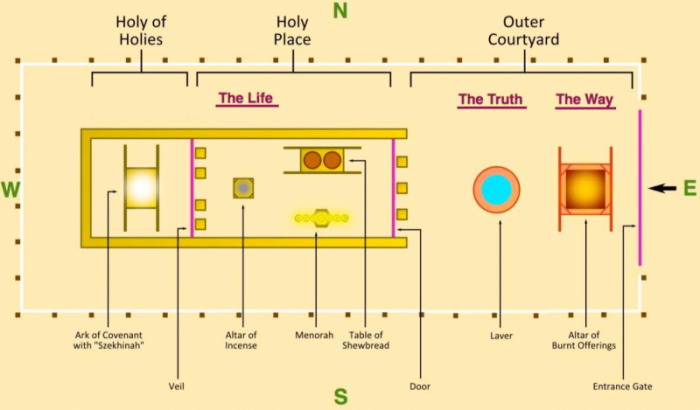
THE DOOR
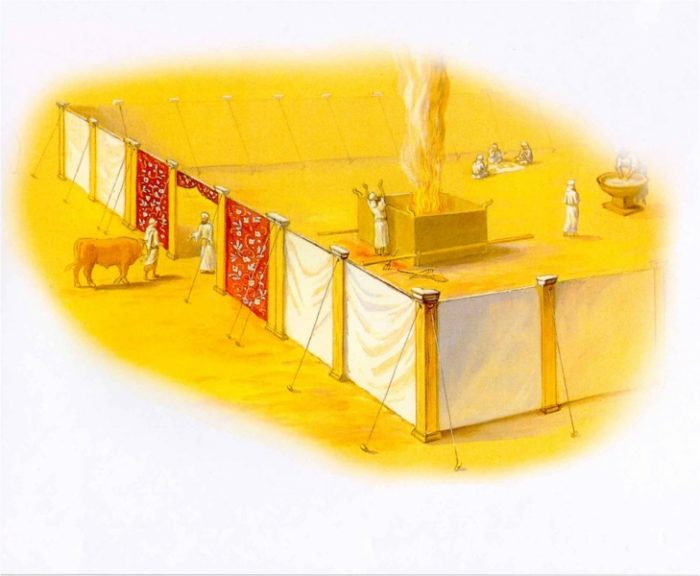
Just as there is only one way into the Tabernacle, even so, Jesus Christ is the only way to God our Father (John 10:9. Matthew 7:13,14). The Jews referred to the entrance of the outer court as “the Way, the entrance to the Holy Place as “the Truth,” and the entrance to the Holy of Holies as “the Life” (John 14:6. 1 John 2:23). Note that the entrance is from the East, where the Sun rises – the Sun of Righteousness or the Daystar (i.e., our Sun is a star that shines in the day)(Malachi 4:2. 2 Peter 1:19). Even though it may seem that your life is in spiritual darkness – remember to look to the East – as the “Son” will rise again! To enter this gate then represents realizing that you need to be saved from sin and seeking Jesus as your personal Savior and Lord.
OUTER COURT
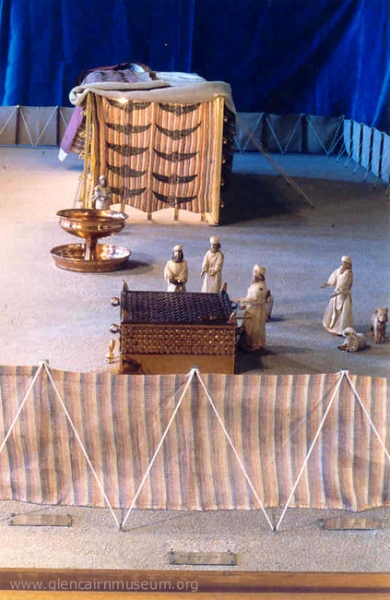
The Outer Court represents the BODY of man (2 Corinthians 5:4). It was surrounded by a 7.5-foot tall fence enclosing an area 75 feet wide by 150 feet long. In this court was located the tent or Tabernacle containing the Holy Place and the Holy of Holies. The outer court is open to the sky, receiving the natural illumination of the Sun and Moon. Here, we learn our first truth – the Tabernacle shows us that we are separated from our holy God’s manifest presence; however, there is a way into His presence.
The outer court contained the Brazen Altar and the Bronze (1) Laver.
BRAZEN ALTAR
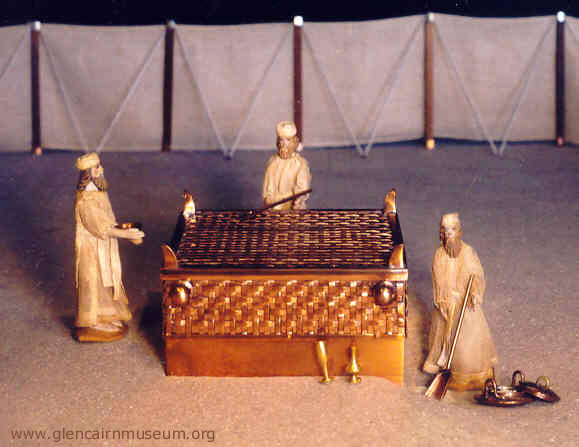
To reach the Holy Place (the first room in the tent), you must pass the altar. It is centrally located in the outer court, standing 4.5 feet high and 7.5 feet square. The altar stood raised on a mound of earth, higher than its surrounding furniture. The altar was made of wood (1) from the acacia tree and overlaid with bronze (Exodus 27:1;38:1), symbolizing judgment on sin ( Numbers 21:8,9).
The Brazen Altar has a lower grate inside to support the sacrifice. Later, a covering grate for the top of the altar was made from the censors used in the rebellion of Korah (Numbers 16:38,39). The wood fire on the altar was to be kept burning at all times, and daily sacrifices were offered (Leviticus 6:8-13).
Each of the four corners of the square altar has an integral horn overlaid with bronze (Exodus 27:2;38:2) as a symbol of strength and protection (Psalms 18:2). Certain sacrificial rituals required the altar’s horns to be smeared with the blood of sacrificial animals (e.g., Leviticus 4:7, 25), and they were used as a place to tie down a sacrifice (Psalms 118:27). Accused criminals seeking sanctuary could cling to the horns of the altar, but it was not automatically guaranteed (Exodus 21:12-14. Kings 1:50–53. 1 Kings 2:28). Amos prophesied that God would cut off the altar’s horns to punish rebellious Israel (Amos 3:14). (2)
The Brazen Altar with four sides and four horns represents our Lord Jesus’s cross with four points (Hebrews 13:10-13). Four means the sacrifice is efficacious for salvation to the world’s four corners (North, East, West, South)! Now that is Good NEWS! Hallelujah! Jesus poured out His blood (1 Peter 1:18,19. Hebrews 9:13,14. Hebrews 10:10,14,18) – His life – on the cross to pay for our sin (1). At 3:00 PM, Jesus, God’s Lamb, died on the cross, which is the same time that the priest in the temple offered up the Passover lamb (John 1:29. 1 John 2:2). This is our call to follow Jesus’ example and empty ourselves of self (Luke 9:23. Romans 12:1). We must pour out (i.e., give up) our life that we might have His life. We must be living sacrifices (i.e., alive to God but dead to sin) (Romans 6:11. Galatians 2:20).
Here, lambs were sacrificed by fire (1) to atone for the people’s sins. Blood or life had to be shed for a person’s sin (Leviticus 17:11. Hebrews 9:22). When a person sinned, they were to bring a lamb to the priest who would kill it as a sacrifice for their sin(s). The lamb’s entrails were burned, and God said this was a sweet-smelling offering. Blood was wiped on the four horns of the altar, signifying the power of the blood to atone for sins even to the four corners of the Earth (Psalms 18:2. Luke 1:69). The lamb’s blood was then sprinkled by the High Priest on the Mercy Seat, with the lamb’s entrails being burned. This consuming of the sacrifice’s flesh produced a stench that God called “pleasant.”
The burnt offering provided a soothing aroma to God as it ascended. From God’s perspective, He was sensing the death, burial, and resurrection of Jesus in that smell, followed by His ASCENSION to Heaven! Including the joy brought in the presence of God’s angels (i.e., the joy brought to God our Father in whose presence the angels live) by the salvation of lost sinners! (Luke 15:10)
The death of self occurs during the fiery trials of life; however, only if we submit to God (1 Peter 4:12). The pain we feel during trials comes from releasing our weaknesses. No more self-will – no more pain (Isaiah 48:10). Furthermore, the death of self-will leads to the resurrection of Christ’s will in our lives! However, only desiring to lose your life will not save it. You must genuinely lose your life in Christ to save your life (Luke 17:33). This cannot be done in our ability but only as we submit to God’s plan for our lives. It is a slow and often painful process that is priceless in its result! We must decrease at the cross for Jesus to increase. For us to get to know in whom we have believed (2 Timothy 1:12), we must first decrease.
BRONZE LAVER
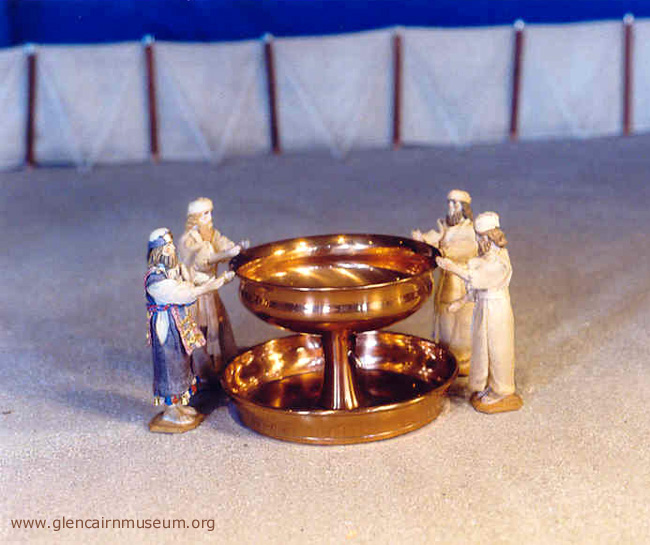
This circular bowl was made from the mirrors of the women who served at the Tent of Meeting (1) entrance. In those days, the ladies’ mirrors were not made of glass as they are today but of polished brass. This bronze would have been flawless since it would have been rejected for mirror use if it were not a visibly consistent alloy of pure tin and copper. (4)
He made the large basin of bronze and its pedestal of bronze from the mirrors of the women who served at the entrance of the tent of meeting. (Exodus 38:8 NET)
The laver was filled with water and located between the Bronze Altar and the entrance to the Tabernacle. God required that the priests be clean when they entered the Tabernacle, so He provided this laver for their cleansing from the soiling of their hands and feet from the sacrifices’ blood (e.g., lambs) and the dirt from the ground. (3)
The Brazen Laver had two washing basins, one for the hands (i.e., cleansing our service for God) and one for the feet (i.e., cleansing our walk with God). Unlike the other items of furniture used in the Tabernacle, Bronze Laver dimensions are not specified.
When we look into the water of God’s Word and see our reflection against His standards of righteousness (i.e., the Bible), we will always come up far short. However, when the priests washed their bloody hands in the laver’s water, the blood and water mingled, and when this happened through the blood of the sacrifice, they measured up in the eyes of the Father. When we look at the Word through the blood, we also measure up. The lack of specific dimensions for the Bronze Laver attests to the limitless power of the Lord Jesus’s blood to wash away all of our sins. (3)
At the cross from Jesus’ side came forth blood and water. This points to the bronze laver, where blood and water mixed to redeem us from judgment (represented by bronze) against our pride and rebellion (pride is a reference to the vanity mirrors used to make the laver ). Blood represents atonement from a life given, and water represents life received through both the Word of God and the Holy Spirit. The Word, Spirit of God, and the blood of Jesus unite to effect salvation or redemption in one’s life. The Bible states that every legal matter must be determined in the mouth of two or three witnesses (2 Corinthians 13:1). God has provided three witnesses to our salvation, each playing a role in and testifying to man’s redemption through Jesus! (3)
For there are three that testify, the Spirit and the water and the blood, and these three are in agreement. (1 John 5:7,8 NET)
The witness of the:
- Spirit of God and His transforming work in our lives.
- Blood points to the remission of past sins and the forgiveness of present and future sins.
- Water points to the Word of God washing, renewing, and cleansing us from sin in the inner man to conform us to the image of Jesus, the Word made flesh.
Again, the Bronze Laver shows that even after becoming a Christian, we must be cleansed continually from sin by the Word of God (Ephesians 5:25-27). Jesus prayed that we would be sanctified by the Word (John 17:17). The Word of God is also referred to as a mirror in the Bible (James 1:23-25). Looking intently into the Word of God will expose the sins and defects in our lives. However, we must take action upon what is revealed, or it will not do any good. It is not enough to just confess our sins. We have not repented (Greek – to turn around 180 degrees from the sin) until we have confessed and forsaken our sins (Proverbs 28:13. 1 John 1:6-9). We are to regret sinning against a Holy God and not just simply regret the consequences of our sinful actions (Psalms 51:1-4. 2 Corinthians 7:9,10). As believers, we are freed from the guilt of sin (Romans 8:1). However, daily cleansing is still needed from sin (John 13:10. 1 John 1:10).
As a priest unto God, we have our bronze laver – the Word of God revealed by the Holy Spirit – available for our cleansing, our sanctification (Revelation 1:6). Furthermore, this cleansing is only found in the Word Himself – Jesus our Savior, Lord, and King! (John 1:1,14). The Promises of God in His Word cause us to have victory over lust and thus escape from the world’s corruption due to sin (2 Peter 1:4). Furthermore, Satan is overcome by the blood-bought Word of God (1) in the hearts and mouths of Christ-conformed believers (Revelation 12:11).
Summary
Figuratively, we enter the Outer Court via Jesus the door when we desire to become Christians. However, if we do not lay down our lives, we will remain in the outer court – it is our choice. Today, many Christians in the church spend their whole lives walking about the outer court without ever entering the Tabernacle. They are enjoying the view of the Tabernacle but have not decided to give up their life so that they can have His life. Realize that simply “desiring” to save your life – even if not acted upon – will keep you from losing it (Matthew 16:24,25).
“He is no fool who gives what he cannot keep to gain that which he cannot lose” – Jim Elliot
A person in the Outer Court that has accepted Jesus as Savior (i.e., identified with the message of the Brazen Altar) has been baptized in the Holy Spirit (1) and thus is part of the Body of Christ (i.e., they are Born Again, Saved, a Christian, etc.). However, because they have not yielded their life to God at the Bronze Laver (Romans 12:1), they have not started to “know Him” (Philippians 3:10) through the study of the Word of God at the Bronze Laver, leading to being cleansed from sinful thoughts and habits (John 17:17. 2 Peter 1:4). Therefore, they remain Phase Zero Christians. Those who choose to lay down their lives and rid themselves of a lifestyle of sinful desires by studying the Word of God (symbolized by the Bronze Laver) will become Phase I Christians (1) and will be enabled to progress into the Tabernacle.
The blood represents a life given, while the water represents a life received.
Lastly, water Baptism (1) is represented by our identifying with the shed blood at the Brazen Altar, representing Jesus’ shed blood at the cross, and His resurrection to a new life by the water at the Bronze Laver.
The Tabernacle of Moses Series:
- God’s Heavenly Pattern for our Spiritual Transformation – Part I: The Outer Court
- God’s Heavenly Pattern for our Spiritual Transformation – Part II: The Holy Place – Gold Lampstand
- God’s Heavenly Pattern for our Spiritual Transformation – Part III: The Holy Place – Table of Showbread
- God’s Heavenly Pattern for our Spiritual Transformation – Part IV: The Holy Place – Golden Altar of Incense
- God’s Heavenly Pattern for our Spiritual Transformation – Part V: The Most Holy Place
- God’s Heavenly Pattern for our Spiritual Transformation – Part VI: The Priestly Garments
- God’s Heavenly Pattern for our Spiritual Transformation – Part VII: Our Great High Priest
- God’s Heavenly Pattern for our Spiritual Transformation – Part VIII: The Women of the Tabernacle
Sacrifices and Offerings of the Old Covenant Series:
- The Fire Sacrifices and Offerings of Israel – Introduction
- The Fire Sacrifices and Offerings of Israel – The “Whole” Burnt Offering
- The Fire Sacrifices and Offerings of Israel – The Meal Offering
- The Fire Sacrifices and Offerings of Israel – The Peace Offering
- The Fire Sacrifices and Offerings of Israel – The Sin Offering
- The Fire Sacrifices and Offerings of Israel – The Trespass Offering
- The Fire Sacrifices and Offerings of Israel – The Red Heifer Offering
- The Fire Sacrifices and Offerings of Israel – The Ordination Offering
Shalom
(Security, Wholeness, Success)
Peace
Then he said to them, “Therefore every expert in the law who has been trained for the kingdom of heaven is like the owner of a house who brings out of his treasure what is new and old.” (Matthew 13:52 NET)
(1) Select the link to open another article with additional information in a new tab.
(2) Major Contributors and Editors. (2016). Horns of the Altar. In J. D. Barry, D. Bomar, D. R. Brown, R. Klippenstein, D. Mangum, C. Sinclair Wolcott, … W. Widder (Eds.), The Lexham Bible Dictionary. Bellingham, WA: Lexham Press.
(3) https://hoshanarabbah.org/blog/2019/02/19/bronze-laver-and-baptism/
(4) Butler, J. G. (2014). Sermon Starters (Vol. 2, p. 56). Clinton, IA: LBC Publications.
(5) Carasik, M. (Ed.). (2005). Exodus: Introduction and Commentary. (M. Carasik, Trans.) (First edition, p. 324). Philadelphia, PA: The Jewish Publication Society.
